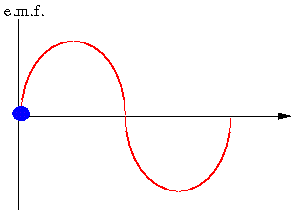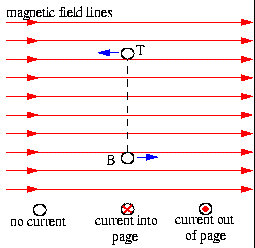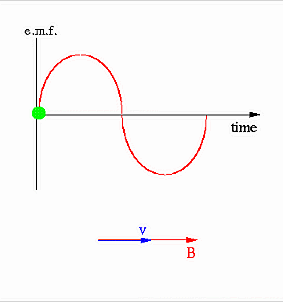
How is an alternating current produced ?
An alternating current is produced by an electric generator. An electric
generator consists of a magnet and a loop of wire
which rotates in the magnetic field of the magnet.
As the wire rotates in the magnetic field, the changing
strength of the magnetic field through the wire produces a force
which drives the
electric charges around the wire. The force initially generates an
electric current in one direction along the wire. Then as the loop
rotates through 180 degrees the force reverses to give an electric
current in the opposite direction along the wire.
Every time the loop rotates through 180 degrees the direction of the
force and therefore the current changes. The changing direction of the
force after every 180 degrees of rotation gives the alternating current.
As well as having the magnet and wire an electric
generator also has slip rings which make sure that the ends of the
wire are always connected to the same side of the electric circuit.
This makes sure that the direction of the current changes every half
revolution of the wire.

|
The diagrams below show how the force that produces the current in the wire
varies as the loop of wire rotates through the
magetic field. The force is given a special name, it is called
the "electromotove force" or e.m.f.
It is similar to the potential difference that gives the flow of electrons
in dc currents and is also measured in Volts.

|

|
Lets now consider what happens to the current in the loop of wire as the wire rotates through the magnetic field. First take the magnetic field to point from the left to the right and the loop of the wire to be initially at right angles to the magnetic field. We will consider the current at the bottom end of the wire labelled B. The loop of wire is rotated in a counter clockwise direction so initialy the end B is moving parallel to the magnetic field. The direction of movement is given by the blue arrows. When the wire is moving parallel to the field there is no emf or electrical current.
As the loop rotates counter clockwise the bottom end moves up and the movement of the loop is now at an angle to the magnetic field. When the movement of the loop is at an angle to the magnetic field an e.m.f. is produced and an electrical current flows through the loop. At the point B the e.m.f produces a current that points out of the screen (at T the e.m.f produces a current pointing into the screen, since both ends of the loop are moving in opposite directions). As the loop moves counter clockwise it becomes aligned with the magnetic field and the movemement of the loop is now perpendicular to the field. At this point the emf becomes it largest and the current is its strongest. As the loop continues to rotate in the clockwise direction the movement becomes more aligned with the field and the emf and current gets smaller. When the loop is again in the vertical position with B at the top of the diagram the direction of rotation is aligned with the magnetic field and the emf and current drops to zero. The loop has rotated through 180 degrees.
As the loop rotates past 180 degees the loop is again moving
at an angle to the magentic field and a current is generated. However
this time the force that creates the current, points in the
opposite direction since the end of the loop, B, is moving down and not up.
Since the e.m.f is in the opposite direction the current at B now
points into the screen. The current at B (and also T) has alternated in
direction and we now have our alternating current. The current is again its
strongest when the loop is parallel to the field and the rotation is
perpendicular. As the loop rotates back to and through the starting
position the current again drops to zero and reverses direction.
This process continues while the loop continues to rotates and only stops
when the loop becomes stationary. The faster the loop rotates the
larger the force on the electric charges and the larger the electric
current.

 is the angle
between the direction of the magnetic field and velocity of the electrons.
When the velocity of the charges is zero there is no electric current since
the force is zero. Similarly when the velocity is aligned with the magnetic
field (
is the angle
between the direction of the magnetic field and velocity of the electrons.
When the velocity of the charges is zero there is no electric current since
the force is zero. Similarly when the velocity is aligned with the magnetic
field (  = 0,180),
= 0,180),  = 0 so the
force is zero and there is
no current. When the motion of the charges (rotation of the loop) is
at right angles to the magnetic field (
= 0 so the
force is zero and there is
no current. When the motion of the charges (rotation of the loop) is
at right angles to the magnetic field (  = 90,270,
= 90,270,
 = 1) the
force has its larges value and therefore there is the most current. As long
as theta does not equal 0 or 180 then there is a force to move the charges
and a current will flow. The current will flow in different directions due to
the velocity at B sometimes pointing upwards and sometimes pointing
downwards. That is why we get an alternating current.
= 1) the
force has its larges value and therefore there is the most current. As long
as theta does not equal 0 or 180 then there is a force to move the charges
and a current will flow. The current will flow in different directions due to
the velocity at B sometimes pointing upwards and sometimes pointing
downwards. That is why we get an alternating current.



|